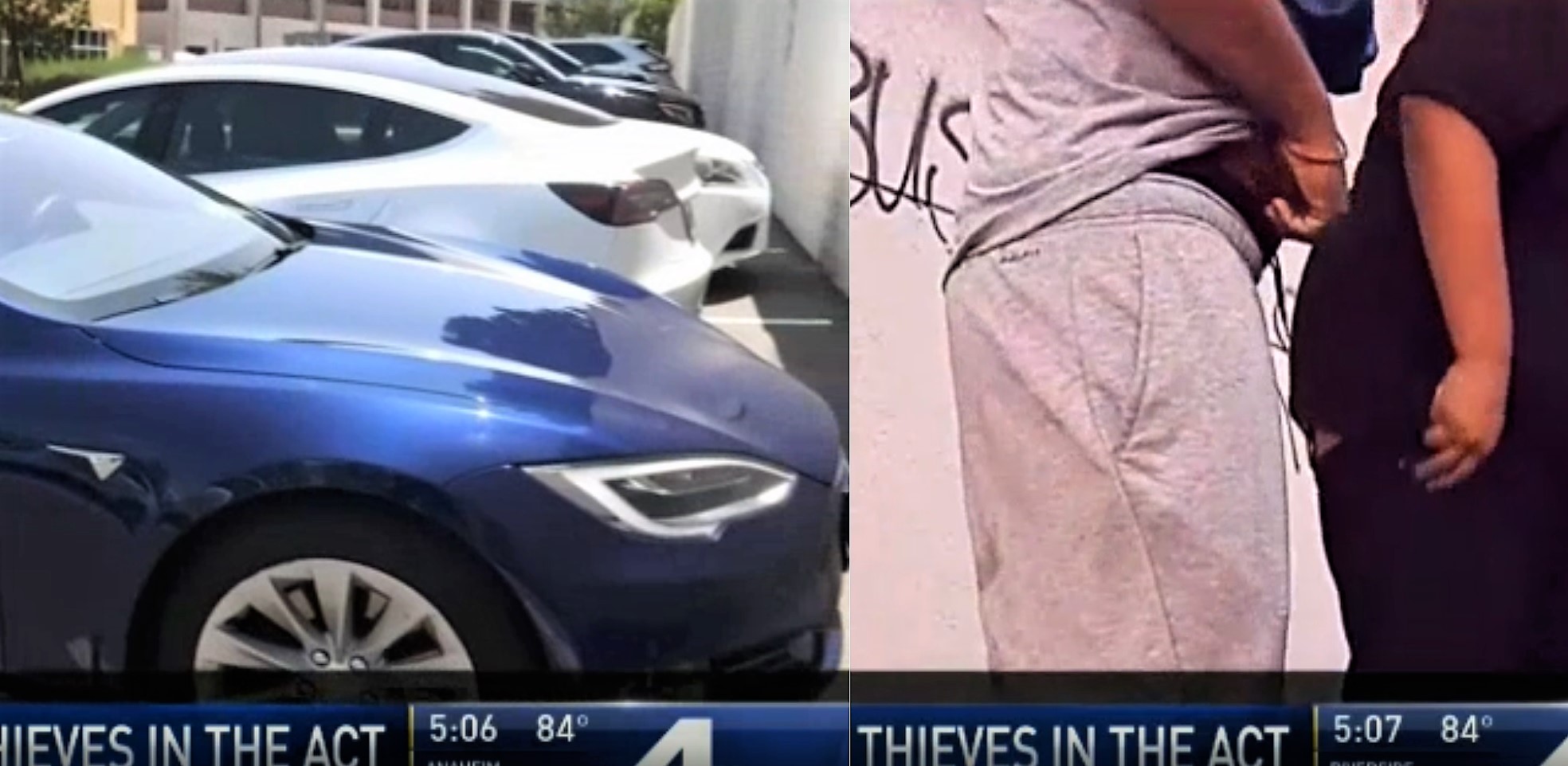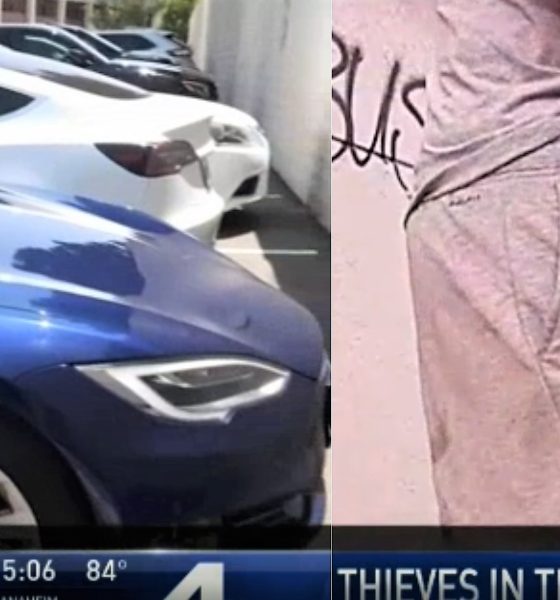

News
Tesla Sentry Mode helps identify thieves after Model S burglary in Los Angeles
Tesla’s Sentry Mode is helping deliver justice again by capturing the faces of thieves involved in a Model S break-in and burglary in California.
The owner of the Model S, a urologist named Nishant Patel who practices in Santa Clarita, returned from a meal in downtown Los Angeles to find that a bag left in the back seat of his all-electric sedan containing a computer, checkbook and expired prescription pad had been stolen after the front right window was shattered. The Tesla app on Patel’s phone had alerted him to the incident immediately after detection, but he unfortunately missed the notification. Thanks to Sentry Mode, however, the entire incident had been captured on video and enabled him to provide police with close-up imagery of the suspects.
As seen in the captured video, two men are involved in the incident. A first man in a straw hat initially peers into the backseat of the Model S, after which he acts excited by what’s found and calls over to a second man dressed in all black. The second man then then breaks the front right window. Both men’s faces are very clear in the footage, and all angles of the break-in were included from Sentry Mode’s use of all 8 vehicle cameras.
At the time of the initial report of the incident by NBC LA, the Los Angeles Police Department had confirmed to Patel that the suspects had been identified, and that he’d be updated once an arrest was made.
- (Image: Nishant Patel/NBC LA)
- (Image: Nishant Patel/NBC LA)
Tesla’s Sentry Mode has been a helpful tool for owners on numerous occasions since its release. In May, the feature captured two vandals laughing as they keyed a Model 3 and dented its door with the door of a Dodge Ram. A disgruntled neighbor was also captured spraying acid on a Model 3 in early June.
Perhaps one of the more well-known incidents assisted by Sentry Mode was a San Francisco break-in that happened in April wherein a Model 3 had its rear quarter window smashed. The car’s security system captured the perpetrator’s face and license plate, but the police did not respond quickly to the incident report, according to the owner. Once the break-in was escalated to the local news, however, the police then investigated and made an arrest shortly thereafter. Another incident in Philadelphia involving a hit-and-run by a local politician was also a well-read headline once the owner released the Sentry Mode video of the entire event.
Although Tesla’s Sentry Mode has already provided owners with a great set of tools to help deter and rectify illegal acts, the car maker continues to improve the feature with over-the-air updates. In response to owner requests, a location-based option was added in May, which enables drivers to set places where Sentry Mode automatically turns on. Among these options are “Exclude Home,” “Exclude Work,” and “Exclude Favorites”. That same update also enabled Sentry Mode to be be activated by saying “Keep Summer Safe,” a phrase taken straight out of Rick and Morty, an animated sci-fi dark comedy that CEO Elon Musk is fond of.
The full NBC LA video report of Patel’s incident is below:

News
Tesla is not sparing any expense in ensuring the Cybercab is safe
Images shared by the longtime watcher showed 16 Cybercab prototypes parked near Giga Texas’ dedicated crash test facility.

The Tesla Cybercab could very well be the safest taxi on the road when it is released and deployed for public use. This was, at least, hinted at by the intensive safety tests that Tesla seems to be putting the autonomous two-seater through at its Giga Texas crash test facility.
Intensive crash tests
As per recent images from longtime Giga Texas watcher and drone operator Joe Tegtmeyer, Tesla seems to be very busy crash testing Cybercab units. Images shared by the longtime watcher showed 16 Cybercab prototypes parked near Giga Texas’ dedicated crash test facility just before the holidays.
Tegtmeyer’s aerial photos showed the prototypes clustered outside the factory’s testing building. Some uncovered Cybercabs showed notable damage and one even had its airbags engaged. With Cybercab production expected to start in about 130 days, it appears that Tesla is very busy ensuring that its autonomous two-seater ends up becoming the safest taxi on public roads.
Prioritizing safety
With no human driver controls, the Cybercab demands exceptional active and passive safety systems to protect occupants in any scenario. Considering Tesla’s reputation, it is then understandable that the company seems to be sparing no expense in ensuring that the Cybercab is as safe as possible.
Tesla’s focus on safety was recently highlighted when the Cybertruck achieved a Top Safety Pick+ rating from the Insurance Institute for Highway Safety (IIHS). This was a notable victory for the Cybertruck as critics have long claimed that the vehicle will be one of, if not the, most unsafe truck on the road due to its appearance. The vehicle’s Top Safety Pick+ rating, if any, simply proved that Tesla never neglects to make its cars as safe as possible, and that definitely includes the Cybercab.
Elon Musk
Tesla’s Elon Musk gives timeframe for FSD’s release in UAE
Provided that Musk’s timeframe proves accurate, FSD would be able to start saturating the Middle East, starting with the UAE, next year.

Tesla CEO Elon Musk stated on Monday that Full Self-Driving (Supervised) could launch in the United Arab Emirates (UAE) as soon as January 2026.
Provided that Musk’s timeframe proves accurate, FSD would be able to start saturating the Middle East, starting with the UAE, next year.
Musk’s estimate
In a post on X, UAE-based political analyst Ahmed Sharif Al Amiri asked Musk when FSD would arrive in the country, quoting an earlier post where the CEO encouraged users to try out FSD for themselves. Musk responded directly to the analyst’s inquiry.
“Hopefully, next month,” Musk wrote. The exchange attracted a lot of attention, with numerous X users sharing their excitement at the idea of FSD being brought to a new country. FSD (Supervised), after all, would likely allow hands-off highway driving, urban navigation, and parking under driver oversight in traffic-heavy cities such as Dubai and Abu Dhabi.
Musk’s comments about FSD’s arrival in the UAE were posted following his visit to the Middle Eastern country. Over the weekend, images were shared online of Musk meeting with UAE Defense Minister, Deputy Prime Minister, and Dubai Crown Prince HH Sheikh Hamdan bin Mohammed. Musk also posted a supportive message about the country, posting “UAE rocks!” on X.
FSD recognition
FSD has been getting quite a lot of support from foreign media outlets. FSD (Supervised) earned high marks from Germany’s largest car magazine, Auto Bild, during a test in Berlin’s challenging urban environment. The demonstration highlighted the system’s ability to handle dense traffic, construction sites, pedestrian crossings, and narrow streets with smooth, confident decision-making.
Journalist Robin Hornig was particularly struck by FSD’s superior perception and tireless attention, stating: “Tesla FSD Supervised sees more than I do. It doesn’t get distracted and never gets tired. I like to think I’m a good driver, but I can’t match this system’s all-around vision. It’s at its best when both work together: my experience and the Tesla’s constant attention.” Only one intervention was needed when the system misread a route, showcasing its maturity while relying on vision-only sensors and over-the-air learning.
News
Tesla quietly flexes FSD’s reliability amid Waymo blackout in San Francisco
“Tesla Robotaxis were unaffected by the SF power outage,” Musk wrote in his post.

Tesla highlighted its Full Self-Driving (Supervised) system’s robustness this week by sharing dashcam footage of a vehicle in FSD navigating pitch-black San Francisco streets during the city’s widespread power outage.
While Waymo’s robotaxis stalled and caused traffic jams, Tesla’s vision-only approach kept operating seamlessly without remote intervention. Elon Musk amplified the clip, highlighting the contrast between the two systems.
Tesla FSD handles total darkness
The @Tesla_AI account posted a video from a Model Y operating on FSD during San Francisco’s blackout. As could be seen in the video, streetlights, traffic signals, and surrounding illumination were completely out, but the vehicle drove confidently and cautiously, just like a proficient human driver.
Musk reposted the clip, adding context to reports of Waymo vehicles struggling in the same conditions. “Tesla Robotaxis were unaffected by the SF power outage,” Musk wrote in his post.
Musk and the Tesla AI team’s posts highlight the idea that FSD operates a lot like any experienced human driver. Since the system does not rely on a variety of sensors and a complicated symphony of factors, vehicles could technically navigate challenging circumstances as they emerge. This definitely seemed to be the case in San Francisco.
Waymo’s blackout struggles
Waymo faced scrutiny after multiple self-driving Jaguar I-PACE taxis stopped functioning during the blackout, blocking lanes, causing traffic jams, and requiring manual retrieval. Videos shared during the power outage showed fleets of Waymo vehicles just stopping in the middle of the road, seemingly confused about what to do when the lights go out.
In a comment, Waymo stated that its vehicles treat nonfunctional signals as four-way stops, but “the sheer scale of the outage led to instances where vehicles remained stationary longer than usual to confirm the state of the affected intersections. This contributed to traffic friction during the height of the congestion.”
A company spokesperson also shared some thoughts about the incidents. “Yesterday’s power outage was a widespread event that caused gridlock across San Francisco, with non-functioning traffic signals and transit disruptions. While the failure of the utility infrastructure was significant, we are committed to ensuring our technology adjusts to traffic flow during such events,” the Waymo spokesperson stated, adding that it is “focused on rapidly integrating the lessons learned from this event, and are committed to earning and maintaining the trust of the communities we serve every day.”










